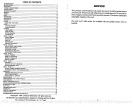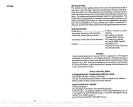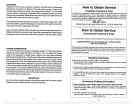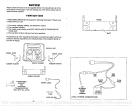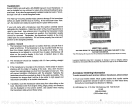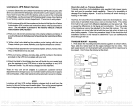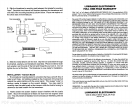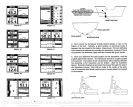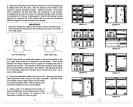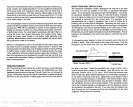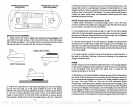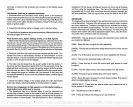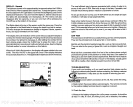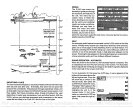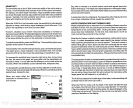
5.
Adjust
the transducer and
bracket so that the front of the transducer
is
slightly
lower than the
back. See the section on fish arches in this
manual for
proper
transducer
angles. Tighten
all screws.
(CAUTION:
Don't
overtighten
the bolt
that holds the transducer to the bracket.
Overtightening
the bolt
may
result in a distorted bracket which will allow
the transducer to
"kick-up"
at
high speed.) Snap
the transducer bracket
together by pressing
the outer bracket
(the
one with the transducer
attached) against
the one screwed to the transom.
NOTE: Some aluminum boats with strakes or ribs on the outside of the
hull create
large
amounts of turbulence
at
high speed.
These boats
typically
have
large
outboard motors
capable
of
propelling
the boat at
speeds
over 35
mph.
The
transducer should be mounted as far below
the hull as
possible
on these boats.
(See below)
This will
place
the face
of the transducer below the turbulent
water,
allowing
the sonar unit to
work at
high speeds.
6. Route the transducer cable to the sonar unit.
Keep
the transducer
cable
away
from other
wiring
on the
boat,
if
possible.
Electrical noise
from
engine wiring
or
bilge pumps
can be
picked
up
on the transducer cable. This can show
up
as
unwanted interference
on
the sonar
display.
7. Make a test
run
to determine the results. If
there is interference on the
display
when
running
the boat at
high speed,
try lowering
the
transducer's bracket as shown at
right.
8 45
a
Cr
r
100 100
GROUP "K"
,0
-
IMPORTANT!
Clamp
the transducer cable to
the transom close to the transducer.
This
will
prevent
the transducer from
entering
the boat if it is knocked
off at
high speed.
F
H,
J
GROUP "B"
sr
0.01
t*a
0.0
MPH
.Qjj
0.OMI 100
GROUP
"A"
ja:• ani;ra
I FEET I I I
45.2 65.4
— 2D$ DI I
IMILESI I
MPH
I
5.4 2.0
GROUP "C"
OMih:•
I
FEET
I
51.1
r
I JOLTS I
T—.
12.6
100
FLAT-BO1TOM HULL DEEP-"VEE" HULL
GROUP "D"
GROUP "E"
GROUP
"P
GROUP "G"
PDF compression, OCR, web-optimization with CVISION's PdfCompressor



